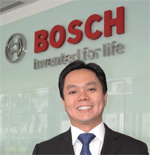Different Standard Implementations
While H.264 is a standard, manufacturers still have some leeway in choosing which tools in each profile should be implemented. This has made decoding the video a challenge, if decoders from different manufacturers are used. Because the tools to encode the video are not the same as the ones used to decode it, the user may see some decoding artifacts.
If anything, this reinforces the notion that open standards of interoperability among IP-based physical security
 |
| Samuel Lee, Product Marketing Manager, Bosch Security Systems |
products are needed. This will eventually eliminate the need for SDKs customized for each brand. Currently there are two groups pursuing the same fundamental goal of bringing interoperability, namely ONVIF and PSIA.
SDKS
Before these standards reach maturity, SDKs will continue to be the chief means of integration. SDKs differ in the level of integration supported. Some only provide high-level integration such as identification, live streaming and PTZ control; others allow finer integration down to tuning the parameters within the physical devices. SDKs also suffer from version control and continuity problems, especially in situations where there is piecemeal upgrading of integrated pieces. One has to consider if this would break the integration done using previous SDK versions.
There are already a number of open platform video management software solutions that utilize SDKs to integrate encoders, decoders and cameras from different manufacturers. Users are also free to choose from the storage and server offerings from various brands.
This translates to greater flexibility for the end user and the opportunity for the system integrator to drive more value through their expertise in integration. They can size up a project and pick the most cost-effective and most technically appropriate platform, rather than be limited to “built-in” choices that usually do not scale up gracefully.
Of course, system integrators would find themselves burdened with the responsibility of selecting each component. The integrators with the strongest competence, and hence those who can drive the most value for their customers, would naturally emerge to be the most successful.